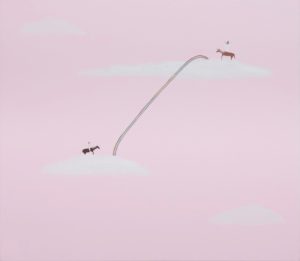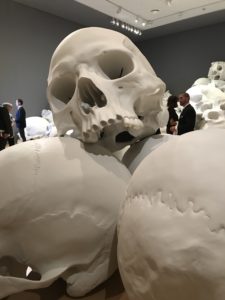Archive for December, 2017

Harrie Fasher, Beersheba and Sculpture by the Sea 2017
Dec 28th
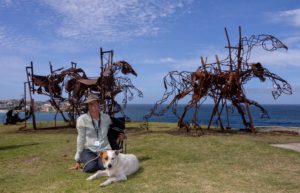
Harrie Fasher with her biggest sculpture to date, The Last Charge, at Sculpture by the Sea in Bondi, Australia, 2017. Image courtesy of Sculpture by the Sea.
This year I had a great interview with rural NSW artist Harrie Fasher about her work for Sculpture by the Sea, titled The Last Charge.
The story was for the Daily Telegraph, and you can see it here.
For the record, however, here’s the interview in full.
Elizabeth Fortescue: Harrie, what materials did you use for The Last Charge?
Harrie Fasher: Corten steel and mild steel.
EF: Did you use oxyacetylene to put it together?
HF: This has been a real battle. It also has industrial I-beams and RHS which is rectangular square section. It’s MIG-welded together and plasma cut. Then ground back using angle grinders.
EF: It sounds very physical.
HF: We’re up and down off the scaffold and the other day I was having a joke about going to step classes at the gym. It is a hugely physical process. There’s no way I could do it alone. I’ve got a team with me in the studio. I’ve got a studio assistant, Megan. She’s been working with me for three and a half years. My farmer next door has been (helping). It’s been very much a team effort. Every artist needs a farmer, is our joke. I live in the middle of a working farm. He’ll help me twist the I-beams or we were heating pieces of steel in a bonfire at one point and he was whacking it with a sledgehammer whilst I was moving it on the chopping block. He has no previous art experience. He’s not overly engaged with the art. But everybody wants to be a part of it. It’s this amazing thing that so many people want to be a part of making art. It blows me away.
EF: Has he helped you with other works for SxS?
HF: Yeah, he’s always helping me. He brings down the tractor so we can move stuff around and load trucks. Metal Land in Bathurst sponsors me and gives me a fair chunk of the steel that goes towards SxS and they lend me their truck. This time it’s going to take two trucks to get it to Bondi. This will be the fourth Bondi that they’ve been involved in. They love it. I don’t know if it’s just a rural thing that there’s all these people that want to be involved in it, but there’s a woman I went to art school with and she lives at O’Connell and she comes whenever she can and cuts pieces. It blows me away how many people want to be a part of things like this. I have a huge network. I think sculptors need friends. I can’t move the sculptures by myself.
EF: What’s the farmer’s name?
HF: Geoff Salmon. And Steve Hogan was my first farmer. (Now he’s making his own sculptures.) He does one or two days a week (for me).
EF: Tell me about your assistant.
HF: My assistant is Nicole O’Regan. She’s a steel fabricator by trade. She’s two years younger than me. Been working with steel since she was 16. Working with another woman is just fabulous. Working with men is quite different. You constantly have to assert yourself a little bit. She’s a crucial part of my team.
EF: How far from Geoff, the farmer, do you live?
HF: I live in the middle of his property of 1200 acres at Oberon. I live in the middle on 12 acres on a property called Essington Park owned by the Logue twins, Joanna Logue and Simone Logue. King Street (King Street Gallery on William) have just taken me on board. I’m going to have my first solo show with them in June. Joanna has the other half of the studio I’m in. The girls’ block, Essington Park, is in the middle of Geoff’s place called Ambleside. Geoff’s son Tim now manages the family property. Sheep and cattle.
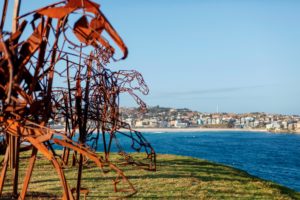
The Last Charge, by Harrie Fasher. Sculpture by the Sea, 2017. Image courtesy of Sculpture by the Sea.
EF: Tell me about The Last Charge.
HF: Eight horses, slightly larger than life. I don’t think I knew what I was taking on. Seven of them are in full gallop. I started the project with a maquette, but I started without a notion of how it was going to look. I wanted to create an emotional response which is to feel what it would have been like to face a full cavalry charge, being over-run, what it would have felt like to be in the Turkish trenches and have these 800 horses galloping at you. And at first I thought I’d make 800 and fill Tamarama Beach and then I thought that would be a bit ludicrous but in reality eight is quite a lot.
One of the horses is fallen. That horse has a real beauty about it. Something quite poetic about the fallen horse. Sometimes I relate to them and I feel them as the men. My mum’s always told me not to anthropomorphise my dogs, but I think I do that with the sculptures. The sculptures are the men, and they embody all these different characteristics that go into making up the myth that’s become part of the Australian culture. They have the courage and the fear and the determination, but they also have a strange ghostliness. Some days I relate to them as this powerful, charging, conquering mass of horses and some days I relate to them as being ghostly.
It was a very successful charge, and one of the only ones because the Light Horsemen actually fought on foot. One person would hold five horses and the rest would fight on foot. Rarely held an old fashioned cavalry charge. It meant the Turkish weren’t able to realign their gun sights. They weren’t prepared for them. The horses were desperate (thirsty). If they didn’t take the town they had a 12-hour ride to water, and there’s that real thing about survival where the men depended on the horses as much as the horses depended on the men. There’s great stories about horses falling in battle and the men then retaliating in revenge for the horse.
EF: All the horses had to be shot at the end of the war, because they couldn’t be brought back home to Australia.
HF: I’ve read how calm it was when they put them down but because the horses trusted the men so much and they were used to gunfire, there wasn’t any panic. They cut their manes and tails and took their shoes off, and hides, because all of that was worth money to the army. Can you imagine skinning your own horse? It would have been heart-breaking. All the time you’d be thinking, ‘oh when I get back with my horse’. People do ask me why I have to have a dead one, a dying one, and I say ‘well it’s a reality check. War isn’t pretty’.
EF: You have two horses on the farm, Dusty and Evie. Did you use them as models for your sculpture?
(Harrie said she saves pictures from the form guide, and also uses horse books.)
EF: Tell me about your forebear who was in the Battle of Beersheba.
HF: Major Lachlan Alfred Macpherson, (known as Alf). He was mum’s great uncle so he was my great great uncle. Born in 1884. We have portraits of him in uniform. I have his medals which I wear on Anzac Day. He won an MC and a DSO. He was at the Battle of Beersheba. The eighth Australian Light Horse. He fought everywhere. He survived the war and came home and settled near Goulburn. I think he was near Gundagai before he went to war. On a property where he grew up. We’ve only just started investigating this connection. It is rather amazing. I went to France on a field trip with a whole lot of landscape painters from King St and Stella Downer and Watters. In May. We were going to do an exhibition on the Western Front. France and Belgium. It gave you a real insight into what they faced and how impossible it was, the missions they were on.
EF: Do you sometimes help Geoff on the farm, the same as he helps you with your sculptures?
HF: Geoff asked me to come and help him pull a cow out of a bog.
EF: Did you get it out?
HF: Yep. She’s out.
Posted by Elizabeth Fortescue on December 28, 2017
Ron Mueck discusses his NGV Triennial installation titled Mass
Dec 27th
For those who are travelling to the NGV Triennial at the National Gallery of Victoria (and you won’t be disappointed) one of the most ambitious works to enjoy is Ron Mueck’s largest installation to date, a new piece commissioned by the NGV for its inaugural NGV Triennial.
Titled Mass, the piece is comprised of 100 giant-sized skulls positioned within the 17th and 18th Century halls of the NGV. Its impact is huge.
I interviewed Mueck for The Art Newspaper, but of course the entire interview could hardly be used in an article. So I reproduce it here for those aficionados who love to hear from the horse’s mouth about an artist’s process and thoughts as they make a work.
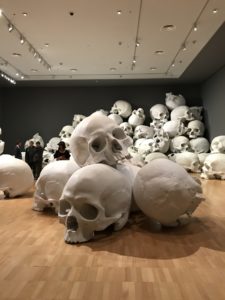
Mass, Ron Mueck’s largest installation to date, is a key work in the inaugural NGV Triennial at the National Gallery of Victoria in Melbourne.
Here’s the interview:
Elizabeth Fortescue: What are the skulls in Mass made from?
Ron Mueck: The skulls are made of fibreglass and polyester resin.
EF: Were you able to make them yourself in your studio?
RM: The short answer is: I started them in the UK and they were completed in Melbourne. The long winded version is: I started the project in my studio in the UK where I sculpted the original skull in water based clay and made a couple of silicone moulds that would ultimately be used to cast multiple copies.
Initially I cast five skulls from these moulds to ensure they worked and to determine the best process and materials.
Because the original clay model gets destroyed in the moulding process, I cast out a ‘master skull’ in resin to make additional moulds from.
This master skull and the two moulds were shipped to Australia.
While we were making the moulds, the NGV were looking into setting up a workshop in Melbourne where the skulls could be produced. This was clearly going to be a better solution than shipping 100 large scale sculptures halfway across the world.
We looked at a few different possible set ups and ultimately decided it would be best to work with an established, specialist fibreglass company with all the necessary facilities in place rather than setting up a workshop from scratch. The NGV found a Melbourne-based company (King’s Fibreglass) who fitted the bill.
I came out to Australia shortly after the moulds and master skull arrived and spent a couple of weeks at King’s working with the skull crew. The skull moulds were quite different to those they usually worked with and we worked through the idiosyncrasies and complications and cast out the first couple of skulls.
Timing was always going to be a major consideration and it became clear that we would need a separate crew dedicated to cleaning up and finishing the casts as they came out of the fibreglass workshop. The NGV put together a group of technicians from their pool of art handlers. Initially there were two but this team expanded to about eight people.
With two moulds it was possible to launch into the casting process but moulds deteriorate as they are used and we knew that we would need additional moulds as the work proceeded. I spent three weeks with another company, Idea Productions, making a third mould and they subsequently made a further two giving us a total of five moulds which meant that at one point there were five, occasionally six skulls being produced a week.
With the production process established I went back to the UK to clean up the studio there and start preliminaries for the next work. Progress reports and images sent to me in the UK kept me up to date. We discussed problems that arose and figured out solutions as necessary but on the whole, due to the talent and dedication of everyone involved, it all ran pretty smoothly.
I arrived back in Oz a couple of weeks before the end of production to join the NGV finishing crew for the final burst of activity.
The Australian end of the project took about eight months.
An extraordinary amount of work achieved to a superb standard by a fantastic team.
EF: Did you use any particular skull as your model for the work?
RM: I made a point of not using a specific skull type. The sex, age and ethnicity of individual skulls is visually apparent and I tried to come up with a somewhat ‘universal skull’ so that the interpretation of the work would not be confined to a particular narrative.
EF: What is the scale of the skulls compared to an actual skull?
RM: I haven’t figured out the exact ratio.
The skulls are about a metre tall sitting on the floor.
I generally just go for what feels right to me when I’m making the work.
I sketched out a couple of different sizes on large sheets of paper, chose the one that felt a good size to stand beside, and then made a three dimensional cardboard mock-up of that size so I could get a sense of it in the round.
EF: Is this your largest work to date?
RM: Yes, although it is a work of variable dimensions. It will be reconfigured each time it is displayed. I imagine the size and atmosphere of each venue will influence the arrangement.
EF: The depiction of the human skull as a memento mori dates back hundreds of years. Can Mass be viewed as a giant memento mori?
RM: Certainly. Memento mori and the vanitas tradition in art remind us of the brevity of life.
EF: Did you have any particular human or world events in mind when you made it? I was reminded of the terrible piles of skulls left behind by Pol Pot’s regime, for example.
RM: Over the years I have collected a number skull images from various sources…from Paul Cézanne’s Pyramid of Skulls to Cambodian killing fields or the catacombs of Paris. These have all played a part in the development of Mass.
by Elizabeth Fortescue, posted on December 27, 2017
Sydney, Australia



